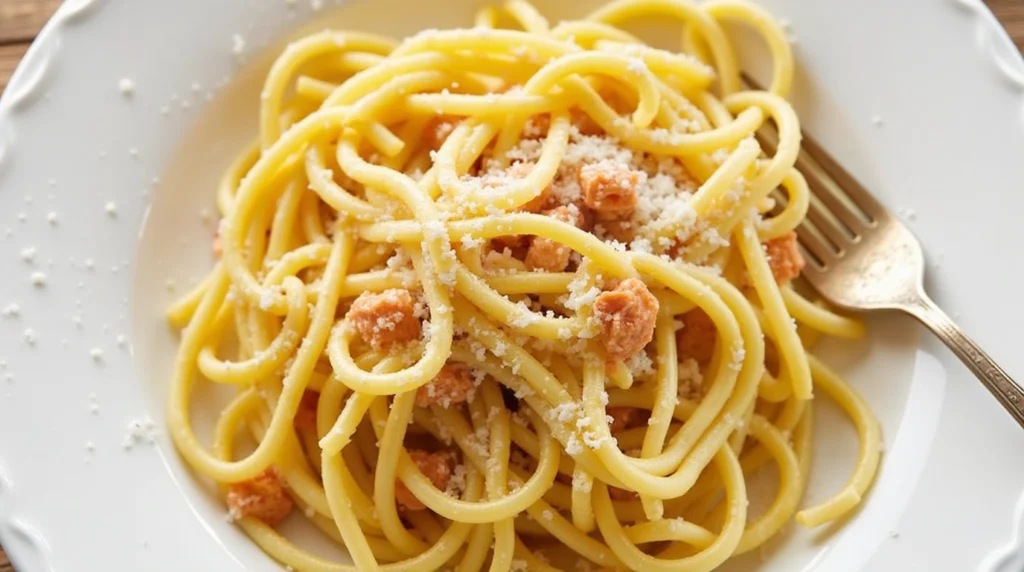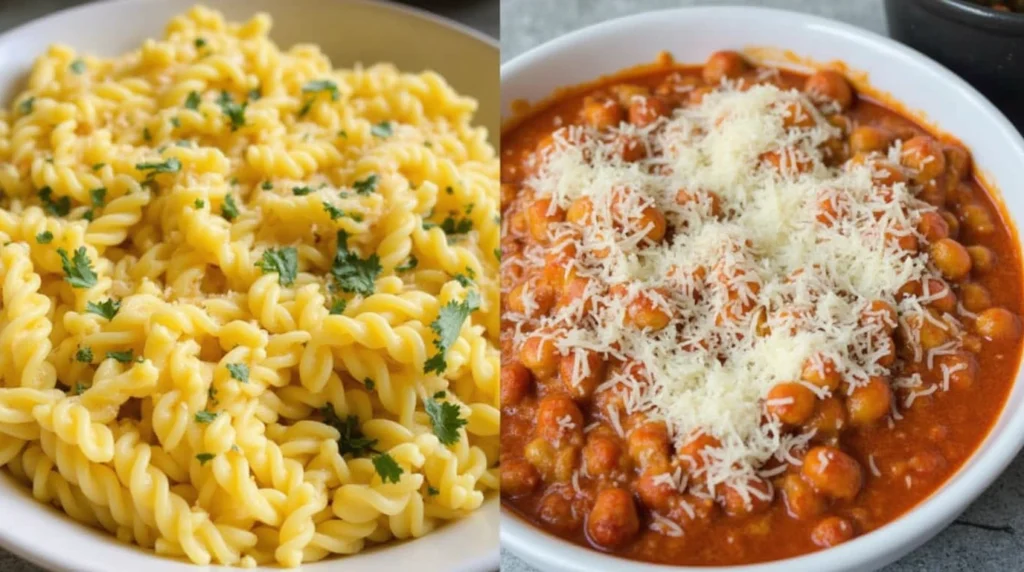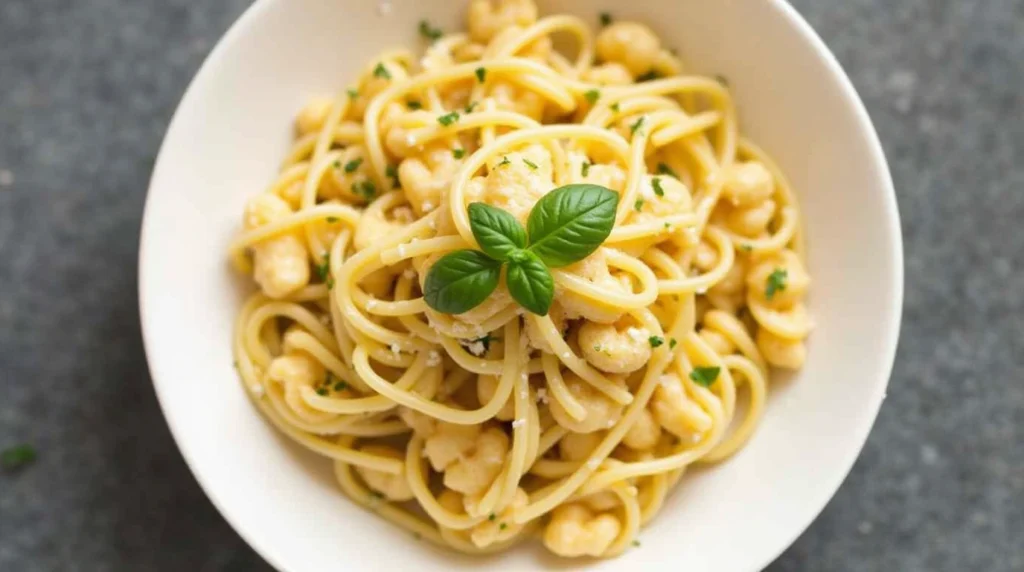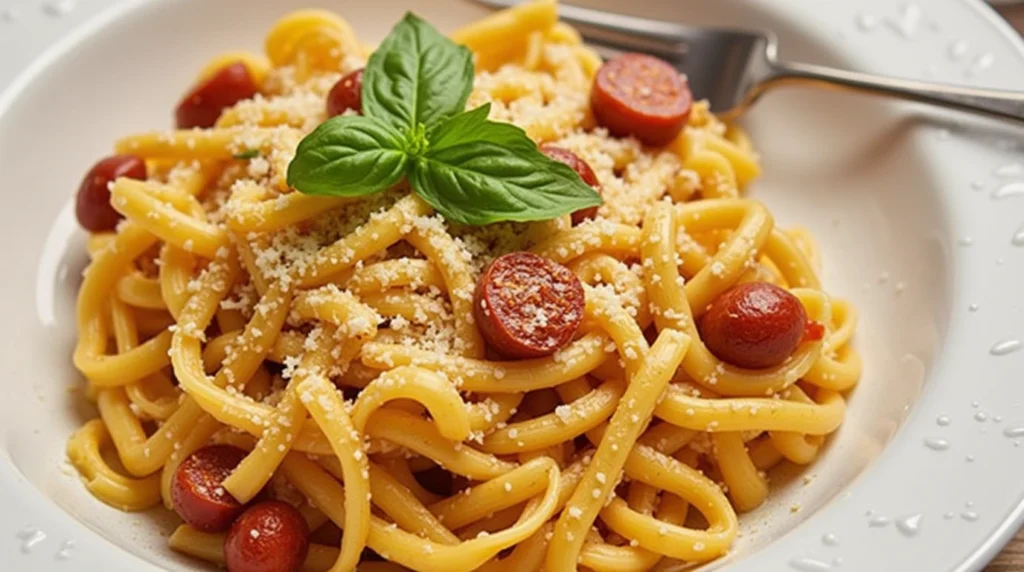Introduction

What are the three most popular pasta dishes? Have you ever sat down to a steaming bowl of pasta and felt an instant connection to something greater than just food? Pasta isn’t merely a dish—it’s comfort, tradition, and a celebration of life rolled into one. For many, it’s more than dinner; it’s nostalgia wrapped in noodles. Whether you’re savoring the creamy richness of Alfredo or the hearty embrace of Bolognese, these dishes have a way of speaking directly to our souls.
In this guide, we’ll explore the three most popular pasta dishes from around the world, uncovering their origins, flavors, and why they deserve a place on your must-try list. By the end, you’ll not only know what makes them special but also how to recreate them at home with confidence.
1. Spaghetti Carbonara – The Classic Roman Favorite
The Origins of Spaghetti Carbonara
Spaghetti Carbonara is a quintessential Roman creation that dates back to post-World War II Italy. Born out of necessity, this dish combines simple ingredients like eggs, Pecorino Romano cheese, guanciale (cured pork cheek), and black pepper. Its humble beginnings belie its global appeal, making it a timeless classic.
- Key Ingredients: Eggs, Pecorino Romano, guanciale, black pepper, spaghetti.
- Fun Fact: Contrary to popular belief, traditional Carbonara does not include cream—a common misconception in international adaptations.
What Makes Carbonara So Popular?
The magic of Carbonara lies in its simplicity and depth of flavor. Here’s why it has captivated palates worldwide:
- Creamy Texture Without Cream: The heat of freshly cooked pasta creates a natural emulsion when mixed with eggs and cheese, resulting in a velvety sauce.
- Balanced Flavors: The salty tang of guanciale pairs beautifully with the nutty richness of Pecorino Romano, while black pepper adds a spicy kick.
Tips to Make the Perfect Carbonara at Home
Ready to bring authentic Roman flair to your kitchen? Follow these tips:
- Use high-quality ingredients—especially the cheese and guanciale.
- Avoid overcooking the pasta; al dente ensures better texture.
- Mix the eggs carefully after removing the pan from heat to prevent scrambling.
| Ingredients | Quantity |
|---|---|
| Spaghetti | 200g |
| Guanciale | 100g |
| Eggs | 2 large |
| Pecorino Romano | 50g |
| Black Pepper | To taste |
2. Fettuccine Alfredo – The Ultimate Creamy Indulgence
The History Behind Fettuccine Alfredo
Fettuccine Alfredo owes its existence to Alfredo di Lelio, a Roman restaurateur who created the dish in the early 20th century. Originally made with butter and Parmesan alone, its rich simplicity quickly earned fans. In the U.S., however, chefs often added heavy cream to enhance its decadence, creating the version most people recognize today.
- Key Ingredients: Fresh fettuccine, butter, Parmesan cheese, optional cream.
- Interesting Note: Alfredo di Lelio originally crafted the dish for his pregnant wife, seeking a comforting yet easy-to-digest meal.
What Makes Fettuccine Alfredo Irresistible?
This dish satisfies cravings for indulgence with its luxurious texture and bold flavors:
- Rich Butteriness: High-quality butter melts into every strand of pasta, coating it in pure bliss.
- Cheesy Goodness: Parmesan adds depth and a savory finish.
Easy Recipe for Homemade Fettuccine Alfredo
To enjoy authentic Alfredo, follow this straightforward recipe:
- Cook fresh fettuccine until al dente.
- Melt unsalted butter in a separate pan over medium heat.
- Stir in grated Parmesan until smooth, adding a splash of cream if desired.
- Toss the sauce with hot pasta and garnish with parsley.
| Ingredients | Quantity |
|---|---|
| Fresh Fettuccine | 200g |
| Unsalted Butter | 100g |
| Parmesan Cheese | 80g |
| Heavy Cream | Optional |
3. Pasta Bolognese – The Hearty Italian Staple
The True Story of Bolognese Sauce
Ragù alla Bolognese hails from Bologna, Italy, where it was perfected by local cooks. Unlike the tomato-heavy versions found globally, authentic Bolognese emphasizes slow-cooked meat and aromatic herbs. This method creates a deeply flavorful sauce that clings perfectly to pasta.
- Key Difference: Traditional recipes use ground beef and sometimes pork, along with milk or cream to balance acidity.
Why Bolognese Is a Global Favorite
There’s no denying the universal appeal of Bolognese:
- Hearty Comfort: The combination of tender meat, ripe tomatoes, and fragrant herbs warms the soul.
- Versatility: While traditionally paired with tagliatelle, Bolognese works equally well with penne, fusilli, or even lasagna.

Best Tips for Cooking a Flavorful Bolognese Sauce
Achieving restaurant-quality Bolognese requires patience and attention to detail:
- Brown the meat thoroughly before adding liquids for maximum flavor.
- Simmer the sauce low and slow to develop complexity.
- Deglaze the pan with red wine to extract caramelized bits.
| Ingredients | Quantity |
|---|---|
| Ground Beef | 300g |
| Onion | 1 small |
| Carrot | 1 small |
| Celery | 1 stalk |
| Tomato Paste | 2 tbsp |
| Red Wine | 1 cup |
Other Famous Pasta Dishes Worth Mentioning
While Spaghetti Carbonara, Fettuccine Alfredo, and Pasta Bolognese reign supreme, other pasta creations deserve recognition too.
Lasagna – Layered Perfection
Lasagna brings layers of pasta, marinara sauce, ricotta, mozzarella, and parmesan together in a harmonious casserole. It’s a comforting dish perfect for gatherings or leftovers.
- Pro Tip: Let the assembled lasagna rest for 15 minutes after baking to set the layers.
Penne Arrabbiata – Spicy and Bold
For those who love heat, Penne Arrabbiata delivers fiery goodness with its tomato-based sauce infused with chili flakes.
- Ingredient Highlight: San Marzano tomatoes provide superior sweetness and acidity.
Pesto Pasta – Fresh and Aromatic
Pesto transforms ordinary pasta into a vibrant feast. Made from basil, garlic, pine nuts, olive oil, and Parmesan, it’s light yet intensely flavorful.
- Storage Tip: Add a drizzle of olive oil on top to preserve freshness longer.
Additional Insights into Pasta Culture and Preparation
While we’ve explored the three most popular pasta dishes, there’s a wealth of additional information that can enhance your understanding and appreciation of pasta culture. Let’s delve deeper into some fascinating aspects of pasta preparation, regional variations, and tips for perfecting your pasta game.
The Art of Making Fresh Pasta
For those looking to elevate their pasta experience, making fresh pasta at home is an art worth mastering. Here are some insights:
- Key Ingredients: Flour (often ’00’ grade), eggs, salt.
- Steps:
- Combine flour and eggs in a mound on a clean surface or bowl.
- Mix until dough forms, kneading for about 10 minutes.
- Rest the dough for at least 30 minutes before rolling it out thinly.
- Cut into desired shapes using a pasta machine or knife.
- Pro Tip: Dust with semolina flour while rolling to prevent sticking.
| Ingredients | Quantity |
|---|---|
| All-purpose flour | 2 cups |
| Eggs | 3 large |
| Salt | A pinch |
Regional Variations in Pasta Dishes
Italy boasts a rich tapestry of regional specialties, each with its own unique twist on classic pasta dishes:
- Northern Italy: Known for creamy sauces and butter-based recipes, such as Risotto and Gnocchi.
- Central Italy: Home to robust meat sauces like Bolognese and simple yet flavorful dishes like Cacio e Pepe.
- Southern Italy: Characterized by tomato-based sauces, seafood, and lighter pastas like Spaghetti alle Vongole.
Healthier Alternatives to Traditional Pasta
If you’re watching your carb intake or seeking healthier options, consider these alternatives:
- Whole Grain Pasta: Offers more fiber and nutrients compared to refined pasta.
- Zucchini Noodles (Zoodles): A low-carb option made by spiralizing zucchinis.
- Lentil Pasta: High in protein and fiber, providing a satisfying alternative.
Expert Tips for Perfect Pasta Every Time
Even experienced cooks can benefit from refining their pasta techniques. Here are some expert tips to ensure perfection every time:
Cooking Techniques
- Salt the Water Generously: Your pasta water should taste like the sea. This enhances the flavor of the pasta itself.
- Don’t Overcook: Al dente pasta retains its texture and pairs better with sauces.
- Reserve Pasta Water: Use this starchy water to adjust the consistency of your sauce, adding body and helping it adhere to the pasta.
Sauce Consistency
- Thick vs Thin: The right consistency depends on the dish. For example, Alfredo should be creamy but not soupy, while Bolognese benefits from a thicker, almost jam-like texture.
- Emulsification: When making creamy sauces, whisk vigorously to create an emulsion, ensuring smoothness.
Presentation Matters
- Garnish Wisely: A sprinkle of fresh herbs, grated cheese, or a drizzle of olive oil can transform the appearance and aroma of your dish.
- Plating Technique: Serve pasta in warmed bowls or plates to maintain temperature.

Cultural Significance of Pasta
Pasta isn’t just food; it’s a cultural icon that transcends borders. Understanding its role in Italian society and beyond adds another layer of appreciation:
Historical Context
- Ancient Origins: While often associated with Italy, pasta has roots dating back to ancient China and the Middle East. Marco Polo is famously credited with introducing pasta to Europe, though evidence suggests it was already present in Italy before his travels.
- Industrial Revolution: Mass production during the 19th century democratized pasta, making it accessible to all social classes.
Social and Familial Role
- Family Gatherings: Pasta is central to Italian family meals, symbolizing unity and tradition.
- Celebratory Dishes: Certain pasta dishes are reserved for special occasions, such as Lasagna for holidays or wedding feasts.
Troubleshooting Common Pasta Mistakes
Even seasoned chefs encounter issues when preparing pasta. Here are solutions to common problems:
Overcooked Pasta
- Solution: Always test pasta a minute before the recommended cooking time. Drain immediately once al dente.
Sauce Not Sticking
- Solution: Toss cooked pasta directly in the sauce over low heat, allowing it to absorb flavors. Alternatively, use reserved pasta water to bind the sauce.
Greasy Alfredo Sauce
- Solution: Ensure the butter is fully melted before adding cheese. Avoid high heat, which can cause separation.
The Global Influence of Pasta
Pasta has transcended its Italian origins to become a global phenomenon, adapting to diverse cuisines and cultural preferences. Its versatility allows it to seamlessly integrate into international menus, making it a beloved staple worldwide.
Fusion Pasta Dishes
As globalization continues to influence culinary trends, fusion pasta dishes have emerged as exciting innovations:
- Asian-Italian Fusion: Think spaghetti with soy-based sauces or ramen noodles tossed in creamy Alfredo.
- Mediterranean-Inspired: Incorporating ingredients like feta cheese, olives, and sun-dried tomatoes for a tangy twist.
- Mexican Pasta: Adding chili peppers, cumin, and lime juice to create spicy, vibrant flavors.
These cross-cultural experiments highlight the adaptability of pasta and encourage creativity in the kitchen.
The Science Behind Great Pasta
Understanding the science behind pasta preparation can significantly improve your cooking skills. Here’s how chemistry plays a role:
Gluten Development
Gluten, formed when flour mixes with water, gives pasta its structure and elasticity. Overworking the dough can lead to tough pasta, so gentle handling is key.
Starch Gelatinization
When pasta cooks, starch granules absorb water and swell, creating the soft texture we love. Undercooking results in hard centers, while overcooking leads to mushiness.
Emulsions in Sauces
Creamy sauces like Alfredo rely on emulsification—the process of combining fat (butter) and water-based liquids (cheese) into a smooth mixture. Proper technique ensures a velvety consistency.
Sustainability and Ethical Choices in Pasta
In today’s world, consumers are increasingly conscious of sustainability and ethical practices. Here’s how you can make responsible choices:
Choosing Eco-Friendly Pasta
- Organic Options: Opt for organic pasta made from sustainably grown grains.
- Locally Sourced Ingredients: Support local farmers by purchasing regional products.
- Reducing Waste: Plan meals carefully to minimize leftover pasta and repurpose scraps creatively.
Plant-Based Alternatives
For environmentally conscious eaters, plant-based pasta offers a sustainable solution:
- Lentil and Chickpea Pasta: High in protein and fiber, these alternatives cater to vegetarian and vegan diets.
- Seaweed Pasta: A novel option gaining popularity for its nutritional benefits and eco-friendly production methods.

Pasta Around the World
While Italy remains the epicenter of pasta culture, other countries have embraced and reimagined this versatile dish:
International Variations
- France: Ratatouille-stuffed cannelloni showcases French flair.
- Spain: Paella-inspired pasta blends seafood and saffron for a Mediterranean twist.
- Japan: Udon pasta served in rich miso broth highlights the harmony between Eastern and Western techniques.
Cultural Adaptations
Each region tailors pasta recipes to suit local tastes, proving that tradition and innovation can coexist harmoniously.
Mastering Presentation and Plating: What are the three most popular pasta dishes?
The visual appeal of a dish is just as important as its taste. Here’s how to elevate your pasta presentation:
Layered Textures
Combine contrasting textures, such as crispy breadcrumbs atop creamy Alfredo or crunchy vegetables in a light pesto sauce.
Colorful Garnishes
Use vibrant herbs, cherry tomatoes, or edible flowers to add pops of color and freshness.
Creative Shapes
Experiment with unique pasta shapes to enhance both aesthetics and functionality. For example, orecchiette (“little ears”) holds chunky sauces beautifully.
Conclusion: What are the three most popular pasta dishes?
From the creamy allure of Carbonara to the indulgent richness of Alfredo and the robust satisfaction of Bolognese, these three pasta dishes represent the pinnacle of culinary artistry. Each tells a story of tradition, innovation, and passion.
Now that you’ve learned about what are the three most popular pasta dishes, it’s time to roll up your sleeves and try them yourself. Share your favorite pasta memories or creations in the comments below—we’d love to hear from you!
FAQ Section: What are the three most popular pasta dishes?
Q: What are the three most popular pasta dishes?
A: Spaghetti Carbonara, Fettuccine Alfredo, and Pasta Bolognese are widely regarded as the most beloved pasta dishes globally.
Q: Can I substitute ingredients in these recipes?
A: Absolutely! Feel free to experiment based on dietary preferences or availability. Just remember to maintain balance for optimal flavor.
Q: Which pasta dish is easiest to make?
A: Spaghetti Carbonara is considered beginner-friendly due to its minimal ingredients and straightforward preparation process.
Q: Where can I find authentic pasta recipes?
A: Look for cookbooks wri
